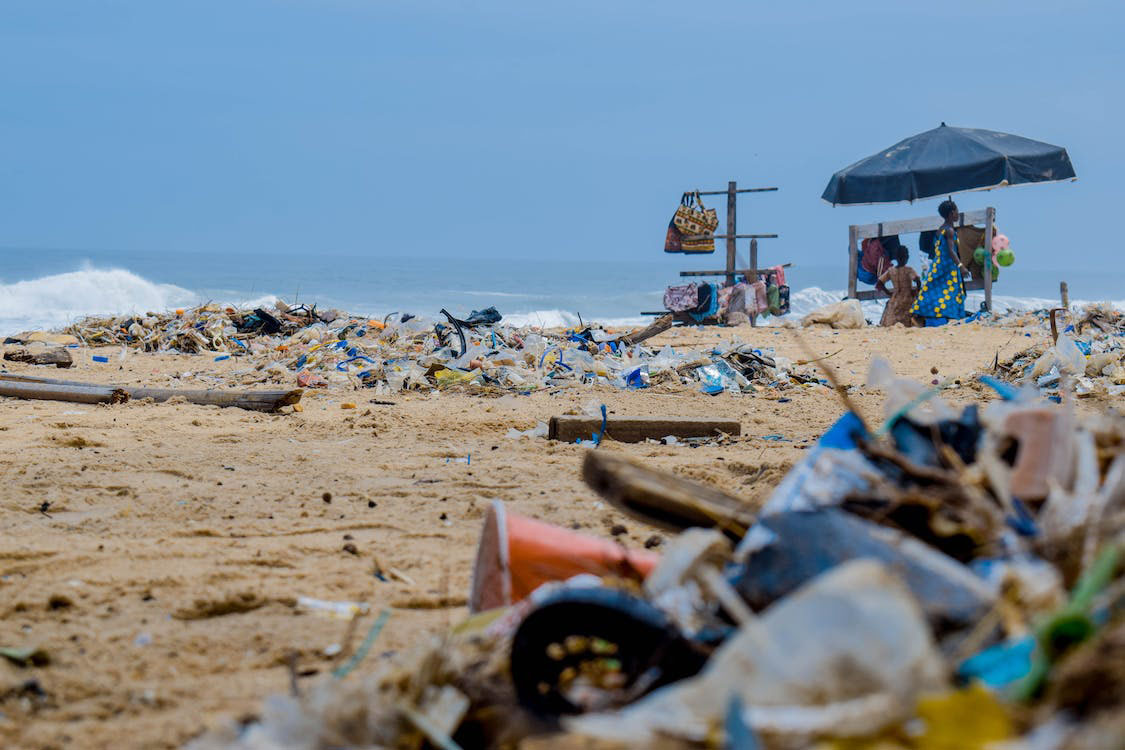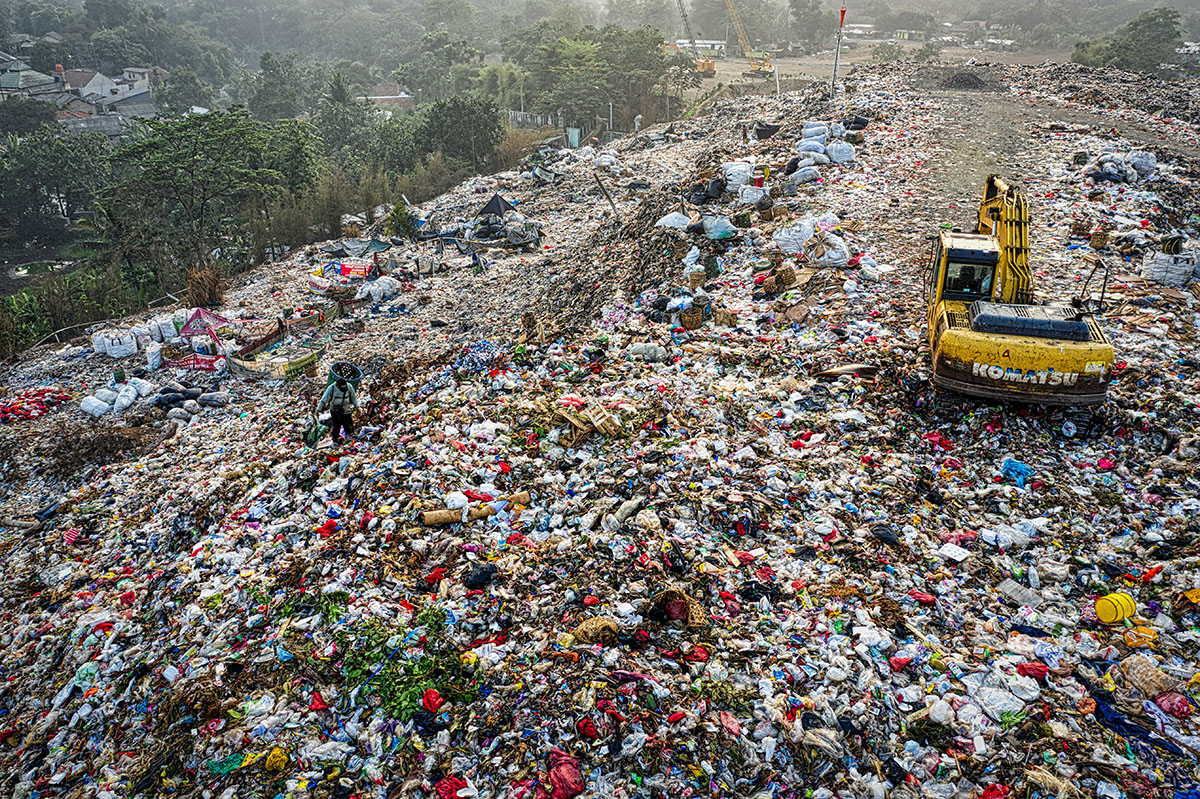Plastic is ubiquitous. Plastic production, consumption and subsequently waste/pollution is increasing at an alarming rate. Annual production of plastic has grown from under 2 million tonnes (Mt) in 1950 to 460 Mt in 2019 and is on track to triple by 2060. If current production and waste management trends continue, roughly 12,000 Mt of plastic waste will be in landfills or in the ocean by 2050. Plastic waste is entering the ocean at a rate of about 11 Mt tons a year, harming marine life and damaging habitats.
Several estimates suggest that by 2050, 99% of seabirds will have ingested plastic. Marine litter harms over 600 marine species, while 15% of species affected by ingestion and entanglement from marine litter are endangered. Marine plastic pollution endangers the ocean ecosystems on which all humanity depends for food, oxygen, livelihood and well-being. Plastic-related greenhouse-gas emissions are projected to account for around 19% of global carbon emissions by 2040. Therefore, ongoing efforts for developing an international legally binding instrument on plastic pollution (including in the marine environment) are of utmost significance for health of humans and the planet.
At NRI, we are keenly aware of the significance of this historic treaty. In support of its vision to guide focused action against plastic pollution, here are ten outcomes we recommend the negotiators in Nairobi aim to achieve:
- Develop broad and headline consensus on key time-bound targets:
While focusing on comprehensive, well-defined, and circular economy measures across the plastic value chain (production, use and disposal of plastic), it would boost morale and actions if the Nairobi declaration includes some time-bound targets. Targets such as a minimum 75% global reduction in single use plastic production and use by 2040 and/or a global /regional ban on problematic material such as polystyrene by 2030 could be adopted. Problematic materials, whose use can be eliminated and whose reuse is difficult, constitute around 40% of total plastic pollution.
- Arrive at differentiated but firm commitments from all negotiating countries:
 While continuing the negotiations on global targets is paramount, it is also important to arrive at differentiated and country-specific contributions to the global targets in the treaty. A differentiated approach is both just and realistic. There are high, medium, and low ambition countries. These categories reflect their individual realities regarding their contribution to plastic pollution as well as the human and environmental impact of plastic pollution. Ambitions of countries are also tempered by the capacities, resources, and scientific advice available to them. For example, while Small Island Developing States (SIDS), contributed less to plastic pollution, they are heavily impacted by it. SIDS have relatively lower capacities, financial resources, infrastructure, and scientific capabilities to address the problem. Therefore, these are essential conversations to have in Nairobi in order to move forward. Clearly, soft and hard diplomacy would be needed to make this happen.
While continuing the negotiations on global targets is paramount, it is also important to arrive at differentiated and country-specific contributions to the global targets in the treaty. A differentiated approach is both just and realistic. There are high, medium, and low ambition countries. These categories reflect their individual realities regarding their contribution to plastic pollution as well as the human and environmental impact of plastic pollution. Ambitions of countries are also tempered by the capacities, resources, and scientific advice available to them. For example, while Small Island Developing States (SIDS), contributed less to plastic pollution, they are heavily impacted by it. SIDS have relatively lower capacities, financial resources, infrastructure, and scientific capabilities to address the problem. Therefore, these are essential conversations to have in Nairobi in order to move forward. Clearly, soft and hard diplomacy would be needed to make this happen.
- Incorporate incentives for innovations:
It is well recognised that addressing plastic pollution requires a whole new way of production, reuse, recycling, and not ‘regrettable substitution’ options. ‘Regrettable substitution' involves a change from a known hazardous substance/material to one where the hazard is not known but may be as bad or worse. This strongly requires innovations by governments, the private sector, and civil society actors. Without sufficient incentives, the innovations would not be initiated or taken to commercially viable scale. Without innovations, the problem will remain unaddressed or partially addressed. Negotiators in Nairobi will need to inspire business, policy and civil society innovations.
- Build an operational framework at country, regional and global levels:
Intentions expressed in the treaty would obviously need a strong operational framework at multiple scales (national, regional and global). A strong framework for implementation will be needed to ensure equitable and just transition from plastics. Herein governments, the private sector and civil society will play critical roles across the lifecycle of plastic. These roles include reducing virgin plastic production, addressing micro plastic pollution and managing plastic waste to avoid unintentional release of micro and macro plastics into the environment.
- Firm financial commitments:
Each country will need to commit financial resources in line with its agreed commitments and targets on reducing plastic pollution. However, some countries are likely to need support from a global operational framework to achieve their targets. The Organisation for Economic Co-operation and Development (OECD), high-income and other high-ambition countries would need to provide financial resources to a global fund. This fund can then channel these resources to where they are most needed to achieve global and country level ambitions.
- Identify and develop mechanisms to address capacity and other specific challenges:
 Many countries face specific challenges in understanding the severity of plastic pollution, and how plastics flow from terrestrial to aquatic/marine environments. Collection and waste management systems in several countries are rudimentary and need a revamp. Consumer awareness and prevention aspects of plastic waste continue to be a significant challenge in several countries. Specifically, SIDS and Low-and-Middle-income countries face challenges related to data scarcity in terms of mapping and understanding the problems and scientific capabilities to address them. Other challenges include geographical constraints such as limited landfills and how to collect and recycle plastic. Clearly, a multi-pronged collaborative approach will be needed to build capacity on these multiple fronts.
Many countries face specific challenges in understanding the severity of plastic pollution, and how plastics flow from terrestrial to aquatic/marine environments. Collection and waste management systems in several countries are rudimentary and need a revamp. Consumer awareness and prevention aspects of plastic waste continue to be a significant challenge in several countries. Specifically, SIDS and Low-and-Middle-income countries face challenges related to data scarcity in terms of mapping and understanding the problems and scientific capabilities to address them. Other challenges include geographical constraints such as limited landfills and how to collect and recycle plastic. Clearly, a multi-pronged collaborative approach will be needed to build capacity on these multiple fronts.
- Establish a scientific body and a science-policy interface to provide advice and gather evidence on different scales:
Establishing a scientific body to provide advice and gather evidence on different scales is of utmost importance. Also, the treaty will need a technical working group to address specific challenges and guide evidence-informed actions. The treaty will need to convene independent experts, including social scientists at global, regional and national scales to ensure specificity of evidence required at different levels. A formal science-policy interface could be a way to reach out to the right people with the needed scientific and legal expertise to address contentious issues amicably. The interface would be useful to address the current polarisation between stakeholders emphasising the importance of upstream (production and consumption) versus those prioritising downstream (plastic waste management) sources of plastic pollution. A robust science-policy interface at different scales has a better chance of leading to a well-informed and just transition. The interface can crucially guide other mechanisms in different countries which support evidence gathering and solutions-seeking. For example, it can potentially contribute to the UK Research Councils’ science and research agenda to generate useful evidence and impactful solutions.
- Develop metrics and mechanisms for monitoring, evaluation, and learning for tracking progress and impact:
Any treaty without sufficient attention to developing metrics and measuring progress would be a job half done. As indicated by a multi-organisation joint submission to the INC, efficient national reporting under the instrument will require the development of harmonized definitions, standards and metrics. These will enable the collection of relevant, reliable and comparable data covering the entire plastic life cycle. Mandatory reporting of targets (self-disclosure) on appropriately measured baselines (and future estimated baselines /trajectories) would be strongly needed to track progress and impact, and to devise any necessary course-corrections at different scales.
- Develop mechanisms to scale re-use models:
A global movement is happening around reuse models, designed around reuse and repurposing of materials. It is estimated that moving to reuse models can provide over 20% reduction in total annual plastic leakage to the ocean by 2040. Negotiators in Nairobi can prioritise discussions to support the scaling-up of reuse models and develop holistically the incentives and mechanisms to support their operation. This would require support to businesses who are at the forefront of developing these models. It would also require policy interventions to stop subsidising fossil fuels as that would improve the economic logic of reuse models.
- Finally, develop definitions and details in the annexes:
During the Global Plastic Summit organised by The Economist in October 2023, it was noted how the earlier environmental treaties contain much of the detail in the annexes. In the present zero draft, annexes need to be developed with definitions and details of different elements of the treaty. Obviously, existing environmental agreements can guide and inspire the development of detailed annexes, for example in relation to product design criteria, circular economy of plastic and plastic production processes. As The Economist’s ‘back to blue initiative’ notes, the negotiators must agree on the treaty’s key definitions, principles and scope at the upcoming negotiation session. Signing the treaty by the end of 2024 will require an ambitious work programme between the formal negotiations, dubbed the ‘intersessional period’. The upcoming negotiations must deliver a clear mandate for this detailed work.
As some would say, nothing is agreed until everything is agreed. Given the human and environmental impact of plastic pollution, countries have a strong motivation to agree on an ambitious and/or reasonable plan of action. At NRI we hope that the INC and inter-sessional processes will lead to a powerful and actionable draft that can potentially lead to concrete actions at different scales. We eagerly anticipate the outcomes of the third INC meeting in Nairobi with optimism.

